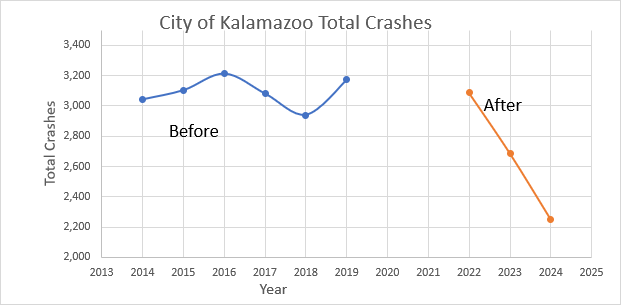Kalamazoo Reports Decline In 2024 Total Traffic Crashes
Published on February 18, 2025
2024 proved to be a safer year for city-wide crashes, final year-long studies from the City of Kalamazoo show thanks to the City’s “Streets for All” initiatives to narrow streets and reduce speeds.
Total 2024 end-of-year data for Kalamazoo reported 2,249 crashes. It is a drop from around 2,700 in 2023 crashes as well as a 27 percent reduction from an average of approximately 3,100 crashes reported between the years of 2014 and 2019. The declines also compare favorably with a statewide reduction of approximately six percent during this period. The chart below shows the reduction in total crashes.

The City of Kalamazoo also experienced a city-wide reduction in bicycle and pedestrian-related crashes of 19 percent – 70 total crashes in 2024 compared with 86 such crashes in the 2014-2019 period. The numbers favorably compare with a statewide reduction of 10 percent.
“The figures show this has not been a one-year phenomenon, but a solid, downward trend,” said Dennis Randolph, Public Works Manager and Traffic Engineer for the City of Kalamazoo. “It’s a trend we believe can be primarily attributed to the City of Kalamazoo’s Streets for All initiative and continued emphasis on reducing speeds and calming traffic.”
According to Randolph, Michigan State Police crash data shows that in the past three years – 2022 through 2024 – Streets for All initiatives have prevented over 1,200 crashes and a minimum of 200 injuries. “The resulting lessening of pain, suffering, and crash-related damage costs significantly benefits the entire community,” said Randolph.
To achieve such significant and positive results, the City of Kalamazoo has implemented many traffic safety and calming measures across the city. These include road diets (changing four-lane streets to three lanes), lane elimination and narrowing, roundabouts, traffic circles, bike lanes and cycle tracks, enhanced pedestrian crossing lighting and signing, pedestrian refuge islands, dynamic signal timing, audible pedestrian crossing signals, signal backplates, changing YIELD signs to STOP signs, adding STOP signs to uncontrolled intersections, general traffic signing upgrades, and speed humps.
“Each of the safety and calming measures we’ve implemented brings its own specific safety benefit,” said Randolph. “By tailoring these devices to specific crash and street characteristics at locations around the city, we are able to maximize safety overall to our street system.”
During 2025, the City of Kalamazoo will continue to apply safety and calming measures across the city. Engineering staff will also conduct further analyses to understand the individual impact of each of the safety countermeasures. The staff, for example, has already taken a preliminary look at the impact of the City’s speed hump program and has found that across the city and on street segments that have speed humps, the average speed of traffic has decreased by about 2.3 miles per hour, and traffic volumes have decreased by about 11 percent. As the following table shows, the residential streets where speed humps have been installed have become much safer for pedestrians and bicyclists.
Speed Hump Effectiveness
|
Situation
|
Probability of Severe Injury
|
Probability of Death
|
|
Before
|
1 out of 5
|
1 out of 12
|
|
After
|
1 out of 7
|
1 out of 20
|
Randolph always touts safety as the City of Kalamazoo’s primary objective. “Our emphasis on the number of people we can prevent from death or getting seriously injured and needing medical attention is the real important point,” he said. “In the end, this will be our most important traffic metric.”